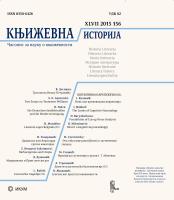Sala declamationum
Sala Declamationum
Jesuit Tragedy in the Context of Post-Trent Theatre and Pedagogical Interculturalism (II)
Author(s): Leo RafoltSubject(s): Studies of Literature
Published by: Институт за књижевност и уметност
Keywords: Jesuit tragedy;Dubrovnik;College theatar;Rethorics baroque;
Summary/Abstract: The article brings forward an interesting phenomena of Jesuit tragedy, as an integrative part of the pedagogical and rhetorical tradition of the 17th century Dubrovnik theatre practice. Introductory parts bring forward theoretical background of the 17th century tragic dram, especially in the context of contemporary tragic theory, starting from George Steiner, Erika Fischer-Lichte and Walter Benjamin, all the way to transcultural approaches in tragic genre history applied by Nicola Savarese. Second part reexamines a history of the Jesuit pedagogical integration in the society and culture of Dubrovnik Republic, from the first post Trentefforts by Gundulić family all the way to their full integration in the 18th century. Thus, main authors of this genre are mentioned and their works, not only those preserved in archival way but also the lost tragic texts, known only by their authors or foreign intertextual source. Furthermore, missing corpus of the Jesuit tragedy is elaborated according to all available historical, theatrical and archival data, and consequentially put in the context of the European performance practices of the 17th century. Special emphasis is put on the Italian tragediography, a natural source for all dramatists of Dubrovnik Republic, but some parallels are given considering the classical tragic legacy of the French 17th and 18th century. Three of the authors were elaborated in more details because of their paradigmatic status in the context of Dubrovnik early modern drama and theatre production: Bartol Kašić, Ivan Gučetić Jr. and Juraj Žuvetić. Finally, elaborated dramas are thus categorized according to their performative status (especially those that are performance-potent, as St. Venefrid by Bartol Kašić), rhetorical apparatus they employ (especially considering Jesuit rhetoric text books and regulations of Ratio studiorum), according to available research materials about them or about their succession, as well as their intercultural habitus. All of the material is tested regarding primary assumptions about the differences between classical tragic legacy and the baroque Trauerspiel made by Walter Benjamin, following Carl Schmitt. In the end, European and Dubrovnik Jesuit drama is defined as a specific genre of the early modern European literary and theatre/performance history, lying somewhere betwixt-and-between rhetorical employment and ideological apparatus, as sala declamationumimmanent topost-Trent council years.
Journal: Књижевна историја
- Issue Year: 47/2015
- Issue No: 156
- Page Range: 253-276
- Page Count: 24
- Language: Serbian

